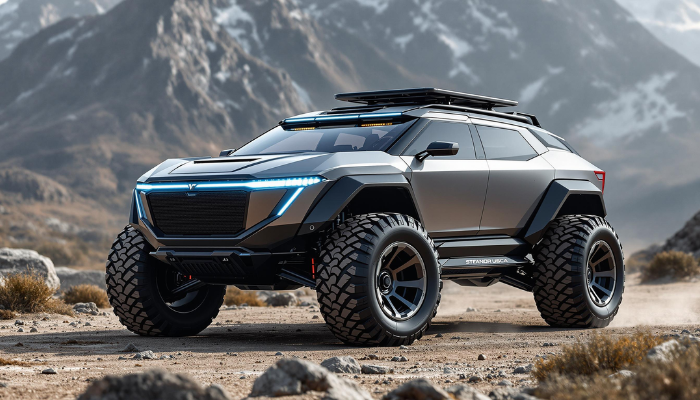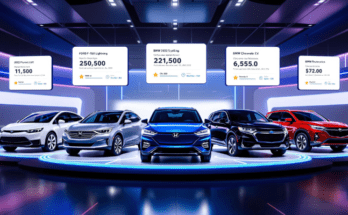Introduction
The SUV has become such a part of our society based on where people can easily get lost in nature and trekking in areas that were previously hard to reach. Advanced design of these vehicles has given them a common association with adventures, work and use for recreation. In the production process throughout the years, manufacturers have tried to achieve great feats which included design and Engineering the models that were more efficient, versatile, and even friendly to the environment. Getting closer to the year 2025, it might be confidently stated that the world of off-road vehicles is still holding numerous vogue ideas within its hands. In the present article, the author will try to unveil some of these trends and innovations we are likely to witness in the next couple of years.
1. Electric and Hybrid powertrains
A major characteristic of future models of off-road vehicles is the integration of electric-hybrid designs into their manufacturing production. Thus, in recent years manufactures have introduced electric and hybrid off-road vehicles as efforts towards minimizing emissions and use of fossil fuels. It is quite likely that the capacity of these vehicles’ batteries will increase, as well as the charging infrastructure will improve in the upcoming 2025.
Electric off road vehicles have some advantages compared to standard gas vehicles. They are less noisy, least pollutive, and possess the ability of immediate power in form of torque within steep incline terrain. Currently, there are some automobile makers who have ventured into performing electric off-road cars for instance Rivian R1T and Tesla Cybertruck. Further, there will be cross-over off-road vehicles that will be frugal both electric and gasoline forms of power, so that optimum performance can be obtained.
2. Self-governing and Partial-self-governing Technology
This is not something that will come as a shock because it will only be a matter of time before technology slowly makes its way into even off-road vehicles. By 2025, more features will likely introduce into off-road vehicles including autonomous and semi-autonomous systems. They can assist a driver with paths through steep crevices; provide a form of hill descent control, rock crawling among other tasks.
Fully automated self driving off road cars will be fully automated and will not be dependent on any input from thedriver but semi automated cars will need partial control by the driver. And these vehicles will have to behave like highly intelligent water ow picked up extensive visible features of the outer environment through advanced sensors, cam- eras and GPS to take decisions in real time. They also are opened to provide going to areas with the usual road vehicles of a regular access, thus increasing the security and productivity.
3. Advanced Suspension and Traction Handling
Off-road vehicles have to be designed for challenge off-road performance; one area has witnessed advances in the recent past is the suspension and traction. There are predictions for further development of these systems in 2025, expecting them to offer improved control and performance in difficult environment.
Future developments on off-road suspension systems likely to be observed will be equipment of the ability to adjust the vehicle to the current road conditions known as adaptive damping and variation of height and attitude of the vehicle in adaptations known as active suspension. Traction systems are also expected to evolve forward, such as torque vectoring and electronic differentials that can increase the amount of grip and stability when on the road that has a low coefficient of traction m.
4. Increased Paths and Directions
Off-road vehicles are employed mostly for exploration and for the spirit of adventure and in the year 2025, more new connected off-road vehicles can be observed with newer connectivity and navigation. Thus, using technology, off-road vehicles may gather data that is needed to navigate and create maps needed for field operations. This may be particularly helpful when the actor must find a path in gnarled territory, or when the actor needs to search an unfamiliar territory.
Also, it improves connectivity with other vehicles in order to exchange the conditions of the road such as the obstacles and other vehicles. Additionally, enhancements in the augmented reality and virtual reality market would enable more off road exploration with even greater engagement.
5. More so, customization and personalization
Off-road vehicles are loved by many because of the aspect of flexibility in their customization to meet a owner’s desire. Based on the developments in 2025, there will be more changes in specialization where the owner can build up this ultimate jeep.
They may range from better suspensions, broader wheelbase, and enhanced or higher horsepower trims besides refined color and interior trims. Advanced personalization might also mean the possibility to upgrade some of car’s software and configurations that would affect the car’s performance depending on the certain type of off-road including rock crawling, sand driving or mud riding.
Conclusion
The future of the off-road vehicles is promising, and it is expected that there are several future developments on the way that would improve the ability of these vehicles and fun to drive them. In future revisions one can presuppose the development of electric or hybrid drive, self-driving or self-steering functions, advanced suspension and wheel slip control systems, expanded connectivity and route planning as well as numerously more choice of different settings and extras. These evolutionary workflows will add onto the flexibility, convenience and ecological sustainability of off-road automobiles to open up more of the beautiful creations in the future.




